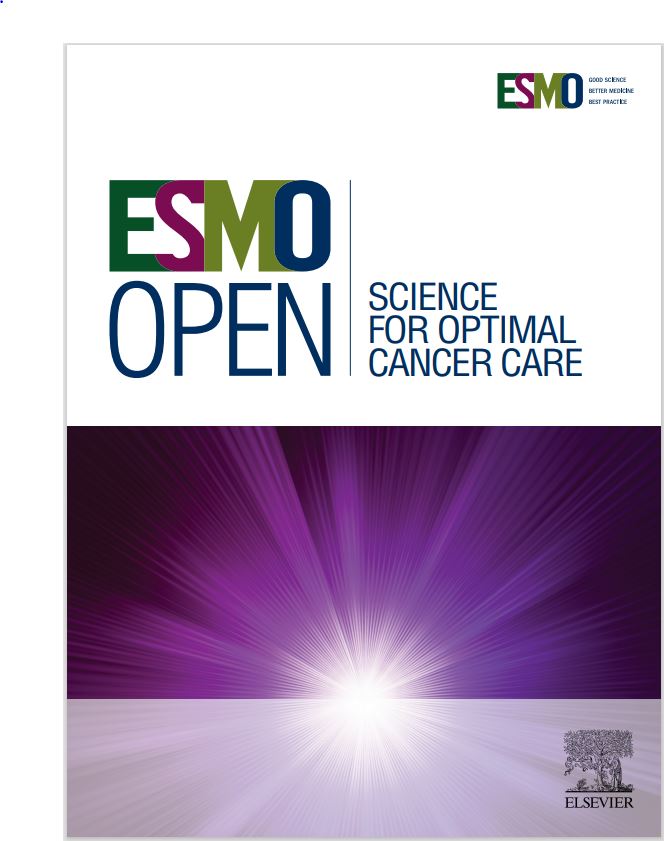肿瘤信息ctDNA检测预测局部晚期头颈部鳞状细胞癌(SCCHN)复发
IF 7.1
2区 医学
Q1 ONCOLOGY
引用次数: 0
摘要
背景:尽管采用了多种治疗方法,局部晚期(LA)头颈部鳞状细胞癌(SCCHN)的复发率仍高达50%。循环肿瘤DNA (ctDNA)已成为治疗意图治疗后最小残留疾病检测的潜在生物标志物。该策略可用于识别复发风险较大的患者,可考虑延长或强化治疗和/或监视成像。材料和方法采用个性化的肿瘤信息16倍多重pcr -下一代测序法检测治疗前(基线时间点)和治疗目的治疗结束后12周内(治疗后时间点)收集的血浆样本中的ctDNA。主要终点和次要终点分别是治疗后ctdna阳性和阴性患者的无复发生存期(RFS)和总生存期(OS)。结果在50例LA SCCHN患者队列中,成功设计了43例患者的个性化ctDNA检测。在这43例患者中,43例患者中有42例(97.6%)在基线时检测到ctDNA。在治疗后时间点,42例患者中有4例(9.5%)检测到ctDNA,其中3例复发。在43例患者中,11例(26%)在随访2年内出现疾病复发。治疗后ctDNA阳性患者的RFS和OS明显低于ctDNA阴性患者(P≤0.05)。ctDNA阳性与临床复发的中位提前期为7.0个月(范围3.6-7.1个月)。结论:在大多数LA SCCHN患者中,个性化的肿瘤信息分析检测到了治疗前的ctDNA。完成治疗目的治疗的12周内ctDNA阳性可预测更差的RFS和OS。这些结果支持了评估纵向检测监测价值的研究,并可能为在LA SCCHN患者分子复发时启动治疗开辟道路。本文章由计算机程序翻译,如有差异,请以英文原文为准。
Tumor-informed ctDNA assay to predict recurrence in locally advanced squamous-cell carcinoma of the head and neck (SCCHN)
Background
Despite multimodal treatment, locally advanced (LA) squamous-cell carcinoma of the head and neck (SCCHN) has a recurrence rate of ∼50%. Circulating tumor DNA (ctDNA) has emerged as a potential biomarker for minimal residual disease detection after curative-intent treatment. This strategy could be used to identify the patients at greater risk of recurrence, for whom extended or intensified therapy and/or surveillance imaging may be considered.
Materials and methods
A personalized, tumor-informed 16-plex multiplex PCR-next-generation sequencing assay was used for the detection of ctDNA in banked plasma samples collected pre-treatment (baseline time point) and within 12 weeks from the end of curative-intent treatment (post-treatment time point). The primary and secondary endpoints were recurrence-free-survival (RFS) and overall survival (OS) of post-treatment ctDNA-positive and -negative patients, respectively.
Results
Out of a cohort of 50 patients with LA SCCHN, personalized ctDNA assays were successfully designed for 43 patients. Among these 43 patients, ctDNA was detected in 42 of 43 (97.6%) patients at baseline. At the post-treatment time point, ctDNA was detected in 4 of 42 (9.5%) patients, 3 of whom relapsed. Of the 43 patients, 11 (26%) experienced disease recurrence within 2 years of follow-up. Patients with post-treatment ctDNA positivity demonstrated a significantly inferior RFS and OS (P ≤ 0.05), compared with ctDNA-negative patients. The median lead time for ctDNA positivity over clinical recurrence was 7.0 months (range 3.6-7.1 months).
Conclusions
The personalized, tumor-informed assay detected pre-treatment ctDNA in the majority of the patients with LA SCCHN. ctDNA positivity within 12 weeks of completing curative-intent treatment was predictive of worse RFS and OS. These results support studies to assess the value of longitudinal testing for surveillance and may open the path to initiating treatment upon molecular recurrence in patients with LA SCCHN.
求助全文
通过发布文献求助,成功后即可免费获取论文全文。
去求助
来源期刊

ESMO Open
Medicine-Oncology
CiteScore
11.70
自引率
2.70%
发文量
255
审稿时长
10 weeks
期刊介绍:
ESMO Open is the online-only, open access journal of the European Society for Medical Oncology (ESMO). It is a peer-reviewed publication dedicated to sharing high-quality medical research and educational materials from various fields of oncology. The journal specifically focuses on showcasing innovative clinical and translational cancer research.
ESMO Open aims to publish a wide range of research articles covering all aspects of oncology, including experimental studies, translational research, diagnostic advancements, and therapeutic approaches. The content of the journal includes original research articles, insightful reviews, thought-provoking editorials, and correspondence. Moreover, the journal warmly welcomes the submission of phase I trials and meta-analyses. It also showcases reviews from significant ESMO conferences and meetings, as well as publishes important position statements on behalf of ESMO.
Overall, ESMO Open offers a platform for scientists, clinicians, and researchers in the field of oncology to share their valuable insights and contribute to advancing the understanding and treatment of cancer. The journal serves as a source of up-to-date information and fosters collaboration within the oncology community.
 求助内容:
求助内容: 应助结果提醒方式:
应助结果提醒方式:


